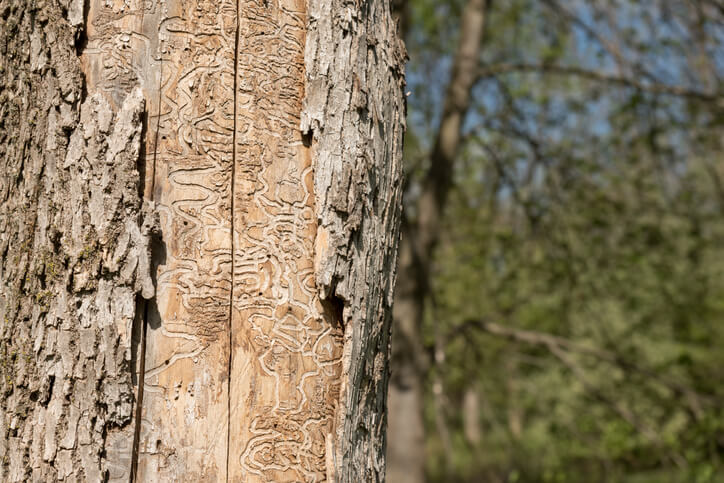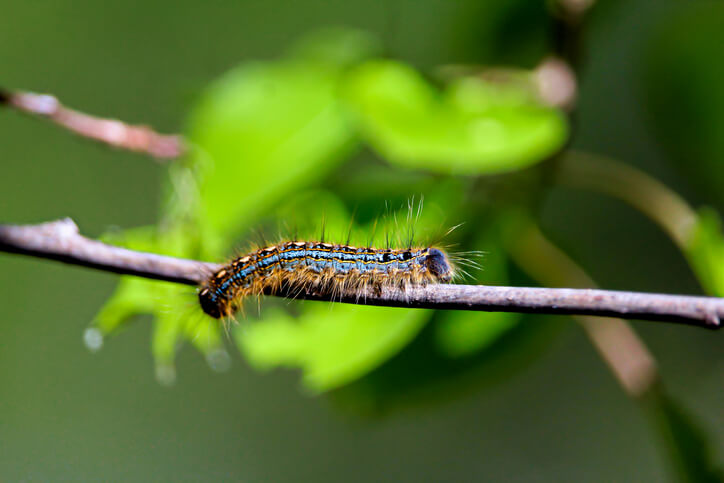TREE EDUCATION

Florida is home to a wide range of tree species and by extension, an equally wide range of tree pests common to our state. Though most pests target and attack unhealthy and weakened trees, some pests can create issues for healthy, mature trees. Professional tree care services, such as those provided by SkyFrog Tree Service, are frequently needed to remove these pests once an infestation has occurred. To schedule service, contact us today!
Insects affect all parts of a tree, from the fruit to the roots. This is why it’s important to be able to recognize the various types of inflicted damage.
Galls are unusual growths found on the branches, leaves, and/or twigs of a tree and range in size from small lumps to complex arrangements. They are caused by more than 1,500 species of insects but may also develop as a result of a bacterial, fungal, or viral infection. The color of galls also has a wide range, from dull brown to bright and vivid colors. Most of the time galls don’t affect the health of a tree but are instead unsightly.
Defoliating tree insects cause tree damage by eating the leaves and/or needles which, if a significant portion is destroyed, the tree itself can die.
Perhaps the most notorious defoliator nationwide, the gypsy moth is prevalent in hardwood trees, such as elm, maple, and oak. The larvae hatch from teardrop-shaped, yellowish eggs in the spring. The eggs are generally laid on the tree trunk and may be in masses of up to 500 eggs. The hungry larvae can cause complete defoliation in a matter of weeks if left untreated.
Bagworms affect a range of Florida trees, including box elder, cypress, juniper, live oak, and persimmon. As caterpillars, they blend plant materials, such as chewed leaves, and silk to create the hallmark bag, holding the eggs, is carried on the female’s back. During the spring these bags and/or cocoons can be seen hanging from branches before defoliation begins after the eggs have hatched in the summer

Common hardwood shade trees, such as oaks and sugar maples, are prime targets for the eastern tent caterpillar. These insects incubate in eggs during the winter, usually in masses of up to 400 eggs which have a black, varnish-like covering. The masses surround small branches near the branch crotch. Larvae hatch in early spring or when the tree buds begin to open and spin silk-like tents in the crotch. Eastern tent caterpillars start as hairy larvae featuring a black body and single white stripe down the back. Adult moths are reddish-brown with two diagonal pale stripes on each forewing.
Wood borers can cause significant damage to a tree’s tissues in a short timeframe but these insects rarely infest healthy trees. The results of an infestation usually include branch dieback, declining overall health, girdling, and structural weakness. If you see or suspect wood borers have invaded your trees, contact SkyFrog Tree Service to speak with a certified arborist.
An invasive species, the emerald ash borer is a flat-headed type of wood borer — wood borers can also be classified as clearwing species. The beetle has a green iridescence coloration of its back while the abdomen is yellowish-brown. D-shaped holes in the tree trunk are the telltale sign of active emerald ash borers. These holes allow the beetles to tunnel deep into the tree, disrupting and damaging crucial layers of tree tissue. Eggs are laid on the tree bark before hatching larvae, which have a white body and dark spine, during the late spring and early summer. Woodpeckers are known to regularly hunt this insect.
An encompassing name for more than 600 related species, the bark beetle tunnels underneath the bark of stressed or weakened trees. Once through the bark, its attention turns to the cambium which, when damaged, can’t supply nutrients and water throughout the tree or produce new cells crucial to tree growth. The leaves and needles slowly change color as the infestation continues and tree failure occurs. Bark beetles have a similar appearance to Southern pine beetles and create a pattern of holes that resemble buckshot in the bark.
Though the Southern pine beetle, most of the time, only infests declining pine trees, they’re known to attack healthy pines when the beetle population increases. An individual beetle has a cylindrical body with a black to reddish-brown coloration. Signs of infestation include small holes in the bark, called emergence holes; running pitch; sawdust at the base of the tree; and white pitch tubes. The crown of the tree will turn a reddish-brown or rust color as the infestation continues, a stark contrast against other green, healthy pines. Females lay eggs 6 feet to 30 feet above the ground with grubs, legless and yellowish-white, feeding on inner bark before becoming larvae. The larvae then move to the outer bark before pupating into mature adults.
Sap-sucking insects have specialized jaws and/or mouth pincers which allow them to pierce the leaves and stems of trees to remove the internal sap. During the feeding, these insects discharge honeydew, a combination of undigested sugar and water. This sticky substance can coat anything underneath the tree, such as sidewalks and vehicles.
Related to spiders and ticks rather than insects, red spider mites are oval-shaped and generally attack deciduous and flowering fruit trees. The eggs are laid on the bark in such numbers that it can look like the tree is covered in red brick dust. With prime environmental conditions, red spider mites can grow from larvae to adults in one week. The rapid development leads to extensive damage as the mites suck fluids from individual leaf cells, causing a flecked or stippled appearance. As the infestation grows, the foliage takes on a bronze and/or yellow coloration while some trees suffer stunted growth or even death.
Soft-bodied insects, aphids suck plant sap from terminal growth leaves, causing the tree leaves to turn yellow and/or wilt. These tiny insects are sometimes difficult to spot as adults rarely exceed one-quarter inch in length and come in a variety of colors, including black, gray, light green, and pink. Aphids reproduce rapidly and form colonies that can quickly overwhelm a tree. Common signs of an aphid infestation include curling, stunted, and/or yellowing leaves along with sap-covered leaves and stems.
Named for their scales or shell-like body covering, scale insects are generally small and less than one-half inch in size. These insects are divided into two categories based on body coverings:
Fruit and shade trees are most prone to scale insect infestations with development on any above-ground part of the tree. As the insects feed, the tree becomes weakened and is more susceptible to other pest attacks, disease and infection.